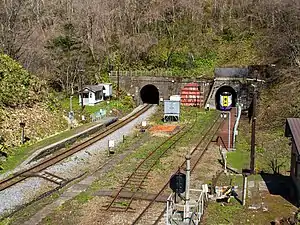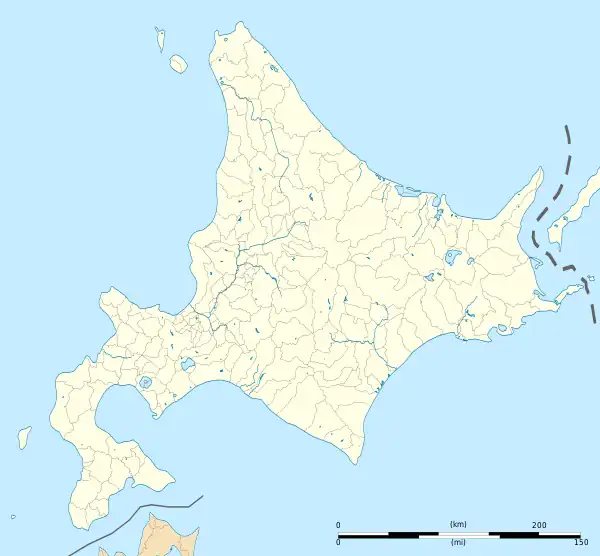Koboro Station
Koboro Station (小幌駅, Koboro-eki) is a railway station in Toyoura, Hokkaido, Japan, operated by the Hokkaido Railway Company (JR Hokkaido).
H45 Koboro Station 小幌駅 | |||||||||||
|---|---|---|---|---|---|---|---|---|---|---|---|
 Full view of the Koboro Station in April 2022 | |||||||||||
| General information | |||||||||||
| Location | Rebunka, Toyoura Town, Abuta District Hokkaido Prefecture Japan | ||||||||||
| Operated by | |||||||||||
| Line(s) | Muroran Main Line | ||||||||||
| Platforms | 2 side platforms | ||||||||||
| Tracks | 2 | ||||||||||
| Construction | |||||||||||
| Structure type | At grade | ||||||||||
| Other information | |||||||||||
| Status | Unstaffed | ||||||||||
| Station code | H45 | ||||||||||
| History | |||||||||||
| Opened | 25 September 1943 | ||||||||||
| Services | |||||||||||
| |||||||||||
| Location | |||||||||||
 Koboro Station Location within Hokkaido  Koboro Station Koboro Station (Japan) | |||||||||||
Located in an 80m-wide gap in between two long tunnels in the cliffs along Uchiura Bay, the station has no road access and is known for being the most secluded station in Japan.[1][2]
Lines
Koboro Station is served by the Muroran Main Line.
Station layout
The station has two side platforms, serving one track each. There is no station building or waiting room, only a small maintenance shed. An outhouse with a bio-toilet is available.
 Platform view for Higashi-Muroran
Platform view for Higashi-Muroran Platform view for Oshamambe
Platform view for Oshamambe Name sign
Name sign
History
The station originally opened on September 30, 1943 as Koboro Signal Box (Koboro shingōjō). It added a passing loop to the then-single-track line and served as a point for token exchange, increasing line capacity in order to meet a wartime surge in demand — at the time, the Muroran Line as well as the Hakodate Main Line had been pressed into service to transportation coal and other materiel for the ongoing Pacific War. Finding a suitable location was difficult, as the track ran through a succession of tunnels in rugged terrain; track duplication was also considered as an alternative. Ultimately, it was constructed on a section with gentler grade as a ″chimney-style signal box″ — an arrangement where stopped trains would remain mostly inside the tunnel, with only the front of the steam locomotive peeking out into the open air to vent smoke. This unusual design was to become a contributing factor in the Muroran Main Line train collision on March 31, 1947.
Despite its classification as a ′signal box′ rather than a 'station', passengers were allowed to board and disembark. Upon conversion of the line to double-track running, the signal box was made redundant and thus reclassified as Koboro Provisional Stop (Koboro kari-jōkōjō) on October 1, 1967. It was promoted to the status of full station and renamed Koboro Station on April 1, 1987 when JR Hokkaido was established. However, the location of the station was not officially defined by the distance for the purpose of fare calculation until March 10, 1990.[3]
In July 2015, JR Hokkaido suggested that the station may be closed due to high maintenance costs and low ridership;[2] it was later announced that this could happen as early as the end of October.[4] However, the local government of Toyoura sought to keep the station open for tourism purposes, and the closure was deferred while they entered into discussions with JR Hokkaido regarding the possibility of subsidizing the maintenance expenses.[5] In December 2015, JR Hokkaido announced that the station would continue to operate in the coming year with financial and manpower support from the town government; the arrangement would be renewed annually after review and consultation with the local authorities.[6] The most recent renewal took place on 28 March 2022.[1]
Surrounding area
- Koboro Cave Ruins (Iwaya Kanon) geosite, part of Toya-Usu UNESCO Global Geopark[1][7]
References
- 日本一の秘境駅 小幌駅について [About Japan's most secluded train station – Koboro Station]. Toyoura Town website (in Japanese). Retrieved 16 December 2021.
- 秘境・小幌駅、姿消す?「マニアのため維持すべきか」 [Secluded Koboro Station may disappear: "do we preserve it solely for the sake of the enthusiasts?"]. Doshin Web (in Japanese). Japan: The Hokkaido Shimbun Press. 18 July 2015. Archived from the original on 18 July 2015.
- Ishino, Tetsu; et al., eds. (1998). 停車場変遷大事典 国鉄・JR編 [Station Transition Directory – JNR/JR] (in Japanese). Vol. II. Tokyo: JTB Corporation. p. 849. ISBN 4-533-02980-9.
- Hibino, Yoko (15 August 2015). "Railway buffs bid farewell to lonely Hokkaido station that opened in 1943". The Asahi Shimbun. Archived from the original on 22 August 2015. Retrieved 15 August 2015.
- 八雲・鷲ノ巣、安平・東追分、根室・花咲 JR、3駅廃止を伝達 小幌駅は存続へ協議 [JR announces closure of 3 stations (Washinosu in Yakumo, Higashi-Oiwake in Abira, Hanasaki in Nemuro) - Discussions to keep Koboro Station open]. Doshin Web (in Japanese). Japan: The Hokkaido Shimbun Press. 2 September 2015. Archived from the original on 2 September 2015. Retrieved 2 September 2015.
- 平成28年3月ダイヤ改正について [Timetable changes for March 2016] (PDF) (Press release) (in Japanese). Japan: JR Hokkaido. 18 December 2015.
- "Koboro Station – Koboro Cave Route". Toya-Usu UNESCO Global Geopark website. Retrieved 16 December 2021.